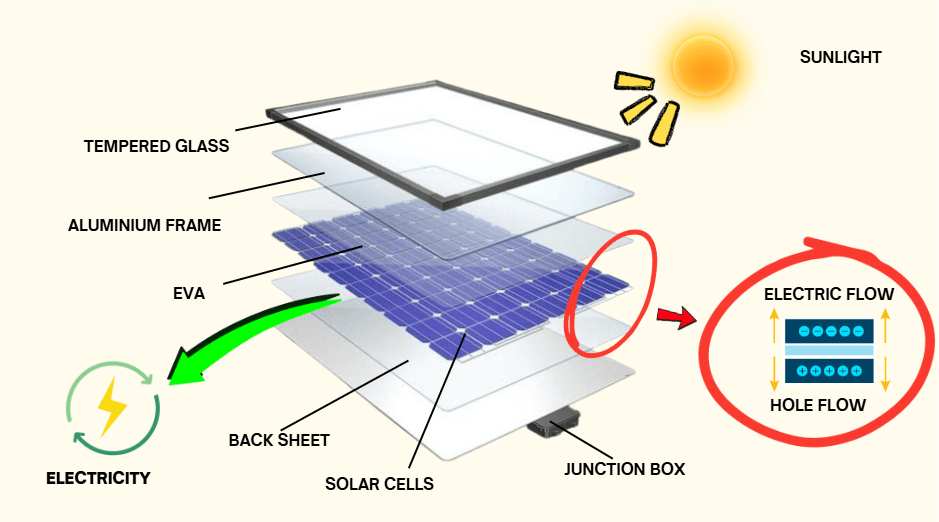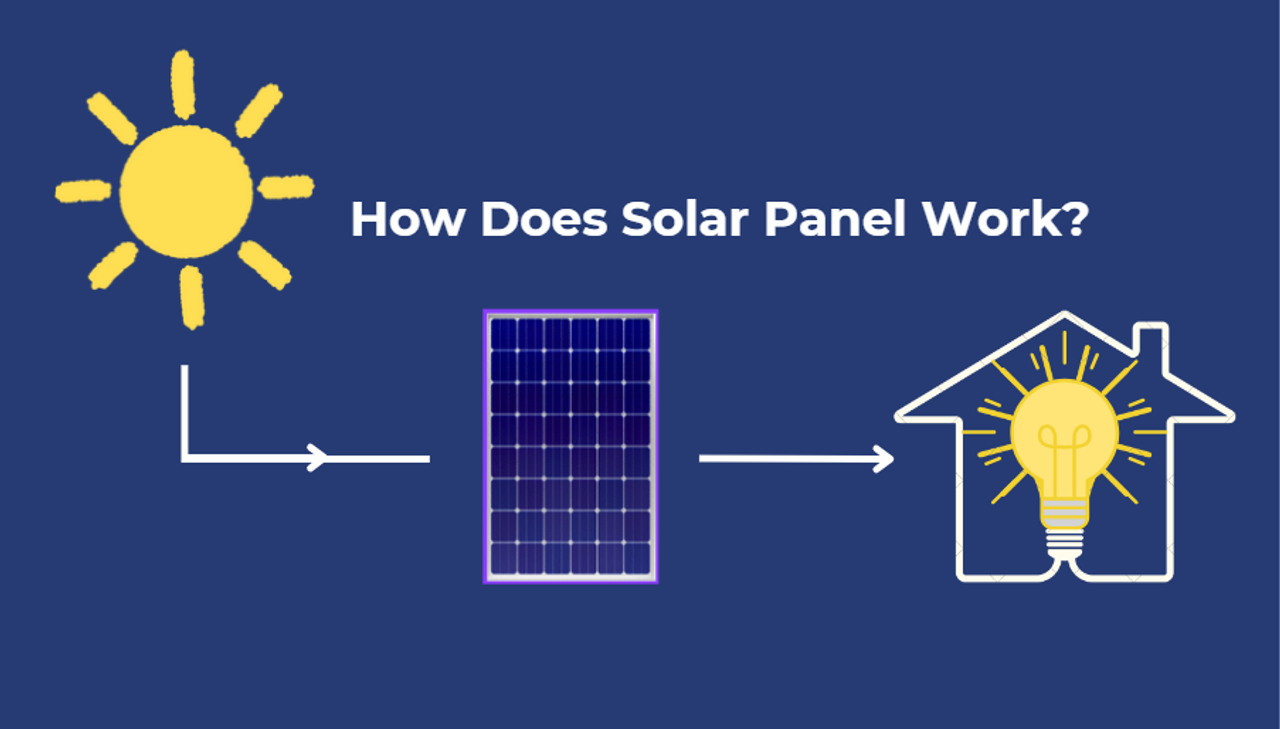How Do Solar Panels Work? Solar Energy Explained
Have you ever looked at solar panels on a rooftop and wondered how they actually work? The process is both elegant and efficient. Solar panels harness the power of sunlight through a remarkable technology called photovoltaic cells, transforming solar energy into electricity that powers our daily lives.
At its core, the process is straightforward. When sunlight hits the photovoltaic cells within solar panels, these specialized cells capture the sun's energy and convert it into direct current (DC) electricity. But since most homes and businesses run on alternating current (AC) electricity, a device called an inverter steps in to transform the DC power into usable AC electricity. This converted electricity then flows through your home's electrical panel, powering everything from your refrigerator to your lighting systems.
Let's explore the inner workings of solar panels and discover how they're revolutionizing our approach to power generation.
Solar energy basics
At the heart of solar power lies our Sun - nature's ultimate power plant that continuously generates energy for solar panels. Inside the Sun's core, nuclear fusion occurs at temperatures of 27 million degrees Fahrenheit, where hydrogen atoms combine to form helium, releasing energy as photons. These light particles travel from the Sun's core to Earth, powering our solar technology.
This natural fusion reactor has operated for billions of years, converting 600 million tons of hydrogen into helium every second. Remarkably, the solar energy reaching Earth in just one hour exceeds our planet's annual energy consumption.
How do solar panels work? The photovoltaic process explained
After sunlight reaches Earth, solar panels capture and convert this energy into usable electricity through the photovoltaic effect. Here's how this remarkable process works:
- Photons from sunlight strike the solar panel's surface and are absorbed by the photovoltaic cells made of silicon
- When photons interact with silicon, they transfer their energy to electrons in the material, exciting them into a higher energy state
- The energized electrons break free from their atoms and begin to move, creating an electrical current
- This flow of electrons generates direct current (DC) electricity within the solar panel
- The DC electricity then flows to an inverter, which converts it into alternating current (AC) electricity
- Finally, this AC electricity enters your home's electrical panel, ready to power your appliances and devices

This photovoltaic process happens instantaneously and continuously as long as sunlight hits the panels. Modern solar panels can convert approximately 15-20% of the sunlight they receive into electricity, making them an efficient solution for clean energy generation.
Alternatives to silicon solar cells
While traditional silicon solar cells dominate the market, innovative alternatives are emerging in solar technology. Thin-film solar cells, made from materials like cadmium telluride (CdTe) and copper indium gallium selenide (CIGS), offer flexibility and lower production costs. These cells can be applied as thin layers on various surfaces, making them versatile for different applications.
Another promising advancement is perovskite solar cells, which have shown remarkable efficiency improvements in recent years. Additionally, gallium arsenide cells and organic photovoltaic cells represent cutting-edge alternatives, each offering unique advantages such as higher efficiency or lower manufacturing costs. These alternatives continue to evolve, promising a more diverse and efficient future for solar energy.
What are solar panels made of?
Understanding the components of a solar panel helps explain how these remarkable devices harness sunlight. Each solar panel consists of several essential elements working together to generate clean electricity:
- Solar Cells: The heart of each panel, typically made of either monocrystalline or polycrystalline silicon. Monocrystalline cells, made from single silicon crystals, offer higher efficiency but cost more. Polycrystalline cells, made from multiple silicon fragments, provide a more affordable option.
- Protective Glass: A durable tempered glass layer shields the solar cells from weather and impacts while allowing maximum sunlight transmission.
- Anti-reflective Coating: This special layer ensures more sunlight reaches the solar cells instead of bouncing off the panel's surface.
- Insulation and Backing: These layers protect against moisture and heat, while providing electrical insulation for safety.
- Wiring and Junction Box: Internal wiring connects the solar cells, while the junction box allows the generated electricity to flow to your inverter.
Together, these components create a durable, efficient system designed to generate clean energy for 25+ years.
How do solar panels generate electricity for your home?
Solar panels rely on the photovoltaic (PV) effect to power your home. When sunlight strikes the silicon cells, it creates an electric field between two differently charged silicon layers. The positively charged layer attracts electrons from the negatively charged layer, establishing an electric current that flows through the panel's conductive metal plates.
This process transforms your rooftop into a personal power station. Today's solar panels come in two main varieties: monocrystalline and polycrystalline. Monocrystalline panels, made from single silicon crystals, typically offer higher efficiency and a sleeker appearance. Polycrystalline panels, constructed from multiple silicon fragments, provide a more cost-effective solution while maintaining reliable performance.
Solar panel efficiency and factors that impact it
Solar power has been steadily gaining traction as a clean, renewable alternative to traditional energy sources. But just how efficient are these high-tech panels, really? And what factors can impact their performance out in the field? Let's take a closer look at the dynamic world of solar energy and unpack some of the key considerations.
What is solar panel efficiency?
Solar panel efficiency measures how effectively a panel converts sunlight into electricity. Today's residential solar panels typically achieve efficiency rates between 15-20%, though premium panels can reach up to 23%. This percentage directly impacts how much power your solar system can generate - higher efficiency means more electricity from the same amount of sunlight, potentially requiring fewer panels for your energy needs.
Factors affecting solar panel efficiency
Several key factors determine how well your solar panels perform:
- Panel Orientation and Tilt: South-facing panels in the Northern Hemisphere typically capture the most sunlight, while the optimal tilt angle depends on your geographical location.
- Shade and Obstructions: Even partial shade from trees, chimneys, or nearby buildings can significantly reduce efficiency. Modern panels with micro-inverters help minimize this impact.
- Weather Conditions: While panels work in all daylight conditions, they perform best in direct sunlight. Temperature also plays a role - surprisingly, panels actually work more efficiently in cooler weather.
- Geographical Location: Your location affects both the amount of sunlight available and seasonal variations in day length. Southern states generally receive more intense sunlight, potentially increasing overall efficiency.
Are there different kinds of solar technology?
While photovoltaic (PV) solar energy is widely used by homes and businesses to generate free, clean electricity, there are in fact other types of solar energy technology available.
Concentrated solar power (CSP) systems offer a promising alternative to traditional photovoltaic solar panels, harnessing the sun's energy through a different approach. These innovative systems use an array of mirrors or lenses to concentrate a large area of sunlight onto a small receiver, which then collects and converts the intense heat into usable electricity. Unlike rooftop solar panels that generate power directly from sunlight, CSP plants leverage the concentrated thermal energy to drive turbines or other generators, making them well-suited for industrial-scale applications that require substantial power output.
Beyond electricity, solar thermal technologies can provide heat for applications like building water heating and enhanced oil recovery. Innovations such as photovoltaic-thermal hybrids, solar fuel production, and floating solar farms highlight the versatility of solar energy. These diverse technologies complement traditional photovoltaics, expanding ways to harness the sun's abundant power.
Conclusion
Understanding how solar panels work unlocks the potential of clean, renewable energy for our homes, businesses, and off-the-grid adventures. Through the photovoltaic process, solar panels capture sunlight and convert it into electricity, offering an eco-friendly solution that reduces dependence on traditional power sources. With advancements in solar technology, brands like Renogy provide reliable, off-grid systems designed for those seeking sustainable energy independence. Whether you're powering your home or a remote setup, learning how solar panels work can be your first step toward a greener, cost-saving future. As solar technology evolves, it's an exciting time to embrace solar energy and make a lasting positive impact on our planet.
FAQs about solar panel principle
Do solar panels work in winter?
Yes, solar panels work in winter as they rely on sunlight, not heat, to generate electricity. While shorter days and snow coverage can reduce output, solar panels still produce power in cold weather, often more efficiently. In fact, solar technology functions well in low temperatures, making winter a viable season for solar energy production. Regularly clearing snow ensures optimal panel performance even during colder months.
At what temperature do solar panels stop working?
Solar panels typically remain functional down to extremely low temperatures, with most panels operating effectively in temperatures as low as -40°F. Performance can decrease slightly in extreme cold, but panels are designed to withstand harsh weather conditions. Higher temperatures, rather than low ones, tend to reduce efficiency, as overheating can affect energy production more than cold temperatures.
How cold is too cold for solar panels?
Solar panels are built to withstand extreme cold, often performing well at temperatures as low as -40°F. Cold weather actually enhances panel efficiency, as cooler temperatures reduce electrical resistance, allowing panels to convert sunlight more effectively. However, extreme cold paired with heavy snowfall can temporarily lower output, though snow can also reflect light and boost energy production once cleared.











